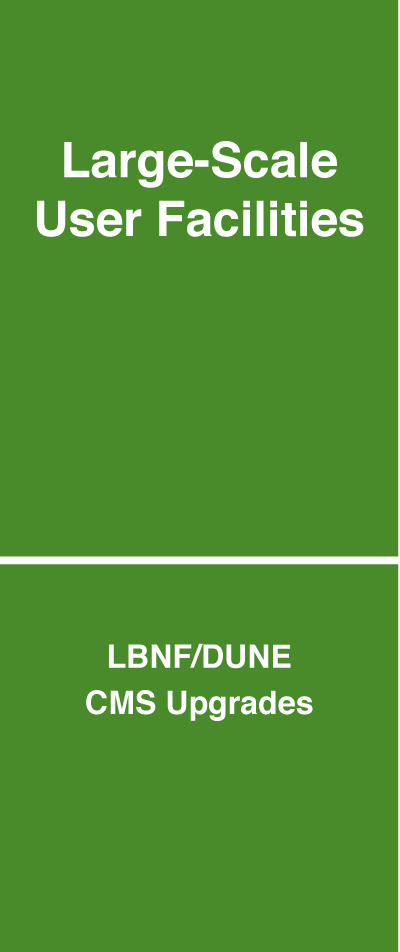Large-Scale User Facilities
LBNF and DUNE
Fermilab’s science strategy sets the trajectory for the United States to lead the world in accelerator-based neutrino science, anchored by LBNF/DUNE. The laboratory has demonstrated excellence in building and operating long-baseline neutrino experiments starting with the MINOS experiment and continuing with NOvA. These projects, together with Fermilab accelerator upgrades, detector R&D to advance liquid-argon time projection chamber (TPC) technology, and the short-baseline neutrino program, set the stage for a flagship international neutrino program based on LBNF and DUNE.
Coupling a massive 70-kiloton underground liquid-argon TPC detector with the world’s most intense neutrino beam, LBNF/DUNE offers unparalleled opportunities for discovering CP violation in the neutrino sector and excellent sensitivity to proton decay, supernova neutrinos, and atmospheric neutrinos. Fermilab, working with international and national laboratory and university partners, plans to host this new long-baseline program that will include intense neutrino and antineutrino beams, conventional facilities at both Fermilab and the Sanford Underground Research Facility (SURF) in South Dakota, an advanced (near) detector on the Fermilab site, and a massive liquid-argon TPC (far) detector and associated cryogenics at SURF. A neutrino experiment of this scale and capability has never been realized. LBNF/DUNE advances the P5 plan by establishing the first phase of this facility with a new beamline and infrastructure for a far detector sited deep underground in the 2020s.
To advance LBNF/DUNE, the U.S. and CERN signed a bilateral international cooperation agreement and approved the subsequent neutrino protocol. In this context, CERN committed to build the first cryostat for LBNF. To support the DUNE prototyping effort, CERN is currently constructing cryogenics, cryostat, beamline, and conventional facility infrastructure for two protoDUNE detectors that are anticipated to be operational before the end of 2018. To deliver the international protoDUNE effort within this timeframe, Fermilab is working with Brookhaven National Laboratory, Lawrence Berkeley National Laboratory, and Argonne National Laboratory as well as the 950-member DUNE collaboration, which includes members from 162 institutions in 30 countries. U.S. membership in DUNE includes both DOE- and NSF-funded institutions.
CMS Upgrades
The CMS and ATLAS experiments at the LHC made the historic discovery of a Higgs boson in 2012, and future research promises to further revolutionize our understanding of the universe. Initiated in 2012 and targeting completion in 2018 for the start of LHC Run 3, the first significant upgrade of the CMS detector will allow collection of high-quality data at event rates and radiation levels three times higher than those recorded in the LHC’s first run. Fermilab is responsible for project management of the U.S. contribution to this upgrade project, which is jointly funded by DOE and NSF and includes upgrades of the forward pixel detector, the hadron calorimeter, and the trigger system. The project includes 30 university partner institutes (all part of the CMS collaboration) that account for 80% of labor and M&S expenditures on the project and contribute to the success of the project by providing expertise available at the universities.
A second and significantly more extensive upgrade of the CMS detector is required to handle the extreme data rates and associated radiation damage that the detector will face during the HL-LHC running period. The CMS collaboration is engaged in detailed planning and R&D activities for the second upgrade. The U.S. CMS collaboration and Fermilab will play a major role in several aspects of this upgrade, including construction of a new forward pixel detector, silicon strip tracker, endcap calorimeter, and trigger. An aggressive, but achievable, upgrade timeline has been developed to meet CERN’s HL-LHC timeline: design and prototyping through 2018; pre-production in 2018-2019; construction in 2019-2024; and installation and commissioning in 2024-2025.
Over the next several years the laboratory will work in conjunction with CMS, DOE, NSF, and university partners to define the role of Fermilab in the second upgrade. DOE CD-0 for the upgrade project was approved on March 7, 2016. The project is targeting CD-1 in FY17, and CD-2/3 in FY19 with a potential CD-3a in the middle of FY18 so that engineering and construction of large prototypes can proceed according to plan.


